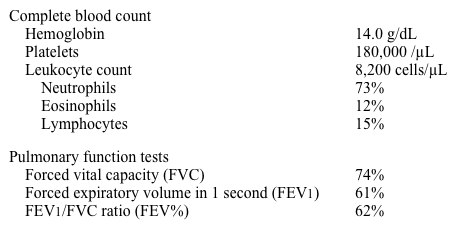A 33-year-old life-long asthmatic comes to the physician with 3 weeks of productive cough of thick brownish sputum, increased wheezing and dyspnea, right-sided pleuritic chest pain, chills, and fever. On occasion, his sputum is streaked with blood. He also notes fatigue and feeling "out of it." His asthma is generally managed with budesonide/formoterol inhaler, and his last exacerbation requiring steroid taper was approximately 2 months ago.
He also took prednisone 20 mg for 4 days at the onset of symptoms three weeks ago "because I had some in the house anyway." The steroids helped somewhat, but the symptoms worsened when he ran out of medication. He has had 2 previous "lung infections on the left side" with similar presentation in the past 3 years. The patient has never been intubated or admitted to an intensive care unit. He denies smoking or recent travel. He had a negative test for HIV 7 months ago.
His temperature is 38.3 C (101 F) , blood pressure is 130/80 mm Hg, pulse is 70 /min, and respirations are 16 /min. Pulse oximetry shows 96% on room air. Examination shows diffuse wheezing throughout the lungs.
Laboratory results are as follows:
Chest x-ray reveals a right upper-lobe infiltrate and possible early bronchiectasis on the left side.
In addition to initiating glucocorticoid therapy, what is the next step in establishing the diagnosis?
Definitions:
Nursing Assistive Personnel
Health care providers who assist nurses in providing patient care, typically with less training and scope of practice than nurses.
Delegating
The act of assigning responsibilities or authority to another person, typically from a manager or superior to a subordinate.
Pressure Ulcer
A localized injury to the skin and/or underlying tissue, usually over a bony prominence, as a result of pressure or pressure in combination with shear.
Nursing Assistive Personnel
Healthcare workers who provide patient care under the supervision of a registered nurse or licensed practical nurse, including activities such as bathing, dressing, and feeding.
Q16: Round 3.0299 to the thousandths place.<br>A) 3.03<br>B)
Q78: Subtract the decimals. <img src="https://d2lvgg3v3hfg70.cloudfront.net/TBX8673/.jpg" alt="Subtract the
Q211: Using the table below determine the value
Q214: A 75-year-old man is admitted to the
Q223: A 32-year-old primigravida at 24 weeks gestation
Q338: A 77-year-old woman is brought to the
Q409: A 24-year-old man comes to the physician
Q418: A 52-year-old woman comes to the physician
Q651: A 72 year-old man with a history
Q793: A 47-year-old woman is evaluated for a